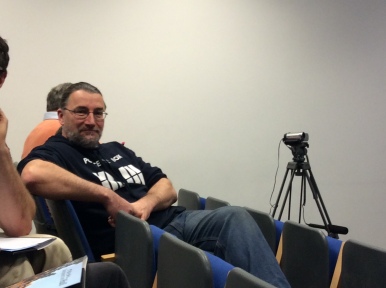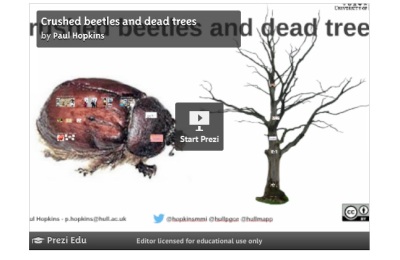Doctoral Writing
Why we blog
Writing a blog about your research can be a great coping mechanism says @mark_carrigan #DSHull #HullEdD pic.twitter.com/hIgbVYkZxR
— Jacqueline Bartram (@jaxbartram) June 5, 2015
A kitten in the garden! My 1st Doctoral Symposium
This post has been re-blogged from:
https://marycryan2013.wordpress.com/2015/06/06/a-kitten-in-the-garden-my-1st-doctoral-symposium/
Having had a very stimulating three days attending University of Hull’s Doctoral Symposium “Operationalising Postgraduate Research:real journeys, real voices,digital worlds” #DSHull I slept late this morning.
Sitting at the kitchen window eating a leisurely breakfast I saw a cat walking down the garden path, behind her were 5 very small, and very cute, kittens. It was obviously their first trip into the outside world, from, what we later discovered ,was their nest under our shed . They looked too small and too fragile to be out at all, but they were having a wonderful time, playing and falling over each other, each taking care of the next and the mother protecting them all.
That was most of the rest of the day gone, kittens being irresistible.
I’m sure you are wondering what this has to do with a Doctoral Symposium?
I’ve been reflecting on the experiences I have had over…
View original post 718 more words
Sympathy at the Symposium
In this post,
Paul Hopkins @hopkinsmmi
offers a considered overview of the Doctoral Symposium and concludes by challenging a few of our ideas about the primacy of words:
http://hulleddmusings.blogspot.co.uk/2015/06/sympathy-at-symposium.html
It’s been a while since I’ve blogged and this post is stimulated by the doctoral symposium that took place at the University of Hull over the last few days:
Operationalising research: real journeys, real voices, digital worlds
Firstly, thanks to Carol Azumah Dennis, Joseph Ploner and Anastasi Gouseti at the Faculty of Education in Hull for their hard work in organising the days, speakers and food!
There is the, “loneliness of the long-distance researcher” that is combatted by such events and the three days reminded my of the reasons I left school teaching and wanted to be in Higher Education – the opportunity to sit around a table and argue about the nature of the human mind as a computational algorithmic device with a sociologist and a philosopher of mind (thanks Mark and John) as well as be inspired, challenged and comforted by the research narratives presented by colleagues old and new.
The symposium explored a number of metaphors over the course of the few days – the journey of course came up and like all metaphors it stretched only so far. However it was good to meet people at different stages of their journey and to, “walk a little way in their shoes” be that at the beginning, the middle or those final stages as they staggered towards conclusion. As well as some keynotes of parts of the process the range of subjects under study by those still on the road was large and fascinating. Be these children oscillating between the liminal space of special and secondary school, how Thai speakers of English are understood by other speakers of English, Goths in the GDR or analysing websites in schools promoting neo-colonialism in Nigeria; to name but a few. As so often in these events it is the conversations in the spaces around the events that help shape ideas, thoughts and processes and there is no doubt that one comes away richer.
My contribution to the event was to challenge some of the orthodoxy in how we present a thesis – entitled “Crushed beetles on dead trees” it questioned the notion of the thesis as x thousands of words on the page. Not that words on the page were not a perfectly good way of expressing ideas, concepts, thoughts and results but that they were not the only way.
Whilst you can see the general idea by clicking on the Prezi above some further text will be useful as I tend to do “just the pictures” when presenting, this will follow shortly. What you might like is the doctoral process presented as an emoji stream – you can add your own captions ;-D
Several people asked me for this after my pres. at #DCHull #HullEdD – the doctoral journey in emoji … pic.twitter.com/O9Au8KKpCt
— Paul Hopkins (@hopkinsmmi) June 6, 2015
The Thought Catcher
Capture and share your thoughts about the literature you’re reading through blogging: @mark_carrigan #DSHull #HullEdD pic.twitter.com/ALAT0sIY1Y
— Jacqueline Bartram (@jaxbartram) June 5, 2015
My evolving relationship with writing
This post has been reblogged from http://leefallin.co.uk/2015/06/my-evolving-relationship-with-writing/ Lee Fallin’s Blog.
I am supposed to be blogging about a conference right now but I can’t. This is a post that has been sitting in my head for far far far too long…
It is all because I have a terrible admission to make. I fell into a trap.
Over the last few years my perception and definition of writing had slowly drifted. Somewhere along the way I stopped seeing writing as the act of forming letters and words to communicate and record ideas. It had become the art of stringing words together for the sole purpose of assessment. This of course is not how I use writing or how I see it – but it became my definition of it despite this fact.
This is a shameful admission to make for a Learning Developer, but can I be blamed? Perhaps it wasn’t a trap at all. Somehow I was dragged into this worldview by the hordes of undergraduates whose sole focus is writing for grades. How can so many people miss the importance of writing in the learning process? Is there any wonder so many undergraduates struggle with writing when the only time they actually write is when they are working on an assignment.
Whenever I teach essay writing to students, I tell them to use a nine step process. Only at stage 8 do I suggest they actually write their essay. All the pre-stages to this involve research, planning and note making. All of this involves a lot of writing. Don’t get me wrong. I don’t think students should be constantly writing pages and pages of linear text. I wholeheartedly believe these preparatory processes do not need to be full sentences and paragraphs. I encourage patterned notes, illustrated notes and linear notes. While all varied, they all need some form of writing and some form of work – and this is the killer. For the majority of students I work with, my suggestion of putting so much effort in something they cannot hand in generates looks of mild horror. The blatantly clear link between this preparatory work and the assignment is not enough.
But I accepted this…
At times I even failed to challenge this.
But not any more.
I guess the problem is that some forms of writing can seem redundant. The slides will be online later, you have a permanent digital copy of the text, you can use a search function to find what you need at any point or maybe you can just access videos and audio of the content itself. As that thought pops into you head you can just write it straight into Microsoft Word as part of your essay… The lists of reasons why is endless. If you see notes as just a memory aid then it is easy to see potential redundancy. What so many seem to miss is their importance in developing writing itself – and not just content.
The thing that annoys me is that I have been giving the correct advice – do lots of writing! I have consistently championed the link between writing for notes and writing for assignments to develop content. The sheer importance of this for developing writing itself somehow escaped me. I guess this is because when I was an undergraduate, I fell into lots of writing. It is just what you did through lectures and as part of seminar preparation (in the age before smart phones and tablets existed)! I’m not so sure today’s undergraduates see things this way…
Doctoral thinking and writing is complicated and difficult. It is also a large step up from masters level and it is clear to me now that I would not be starting to make this step if the only writing I undertake is for my essays and the thesis itself. Indeed, there is literally no way I would have survived the last few months without copious amounts of writing. The more I type, write or draw my thoughts and ideas, the easier things become. The most valuable learning point from my doctoral studies so far has been the importance of writing.
Now I just need to convince a LOT of undergraduates…
Before I end this post, I need to thank @azumahcarol for nudging my views on writing in such a beneficial way and @mark_carrigan for guilting my into blogging again reminding me of the importance of blogging in understanding your own ideas 🙂
One love. One story

A friend of mine who now teaches creative writing in a central London adult education institute – started her career as a well paid and successful actor, theatre director and writer. On one of our regular caffeination sessions sitting in what we fondly referred to as our college annexe, we talked in detail about workplace micro-politics. We called it analysis rather than gossip. The details varied from week to week but the situation was nearly always the same. We would discuss: in this particular set of circumstances what should we do, think or feel? On one of our many occasions, my writerly friend suggested that each of us only ever have one story to tell. Each of us tell our one story again and again and again. The trick, she says – is telling that story in as many different ways as is possible. I like that idea. Not least of all because it reminds me of one my favourite books. I’d like to suggest this book is a deeply influential complex paradigm shifting academic text, but it isn’t. It’s a graphic novel: 99 exercises in style.
This book takes a single story –
a man is sitting at his computer when he decides he wants to go down stairs to get something from the fridge. On his way downstairs someone (off screen) asks him the time. He looks at his watch and says it’s 1.15. He gets to the fridge, opens the door and forgets what he is looking for.
The template for this story is illustrated above.
Is it possible to tell that story 99 times? Below are two (of the 99) versions of it.
1) In one telling he focusses on only the important bits of the story – the hands and the punctuation:

2) In another the story is deconstructed and presented as an inventory of its constituent parts:

In academic writing – empirical or theoretical – we are telling one story.
It really doesn’t matter what we are writing or why. We tell, one autobiographical story. That is: I have come to understand something in a particular way. And this is why. We tell that story again and again and again in everything and anything we write. Because it is autobiographical, I can’t assume my reader knows what I know. If they do, they may not know it in the same way. I have to tell them the story of what and why I think this or that or something else.
The style may differ – that is I might choose to extract and focus on specific details. I may present the details in several different ways. I may even have distinct sub-plots that run through this story.
My colleague Claire Aitchison talks about writing the story of your research in terms of a generic Mills and Boon storyline.
That follows a pattern with its own acronym: IMRAD, introduction-methods-results-and-discussion
But of course this is just one of the 99 possiblities. The template remains the same. I now hold this view of the world and this is why. This is an autobiographical narrative that takes time as the central protagonist. Time is conceptualised as moving forward in a uniform, linear direction. One logical thing after another.
There are there ways to tell your research story – sub plots if you like, or supporting detail and perhaps a change of direction. My colleague Pat Thomson suggests a number of these based on what you feel makes your story worth telling. You have come to understand something in a particular way – but why should we believe you and if we believe you why should we care?
She suggests we may draw on a narrative that follows a slightly different structure:
Thesis to ‘proof’ – you begin with a proposition and then demonstrate its veracity by considering evidence and counter evidence.
Problem to solution – a problem or problematisation is outlined and then the steps to a ‘solution’ – or a different problematisation – are laid out. Alternative solutions are considered and reasons for rejecting them given.
Question to answer – a question is posed at the start, and justified – and the answer built up. Alternative answers are considered and dealt with along the way.
Compare and contrast – the topic is presented and the need for a comparison is given. Material which compares and contrasts is presented and lessons drawn from the exercise.
Cause and effect, or effect and cause – either the cause or effect is presented and justified. The connections are traced and evidenced. The implications of knowing the now apparent causal relationship are elaborated.
Known to unknown or unknown to known – the initial state of knowing or unknowing is outlined and a rationale given for why it is important to un/know it. The reader is led through a set of steps to the opposite condition and the So What – why we needed to do this – is explained.
Simple to complex – a simple or commonsense understanding is presented, and then a set of issues which complicate the initial situation are outlined. Reasons are offered for the importance of these more nuanced understandings.
All of these are of course different ways to tell the same story. Your story about what you now know that you didn’t know before.
Reference
Madden, Matt (2006) 99 ways to tell a story: exercises in style, London: Jonathan Cape



